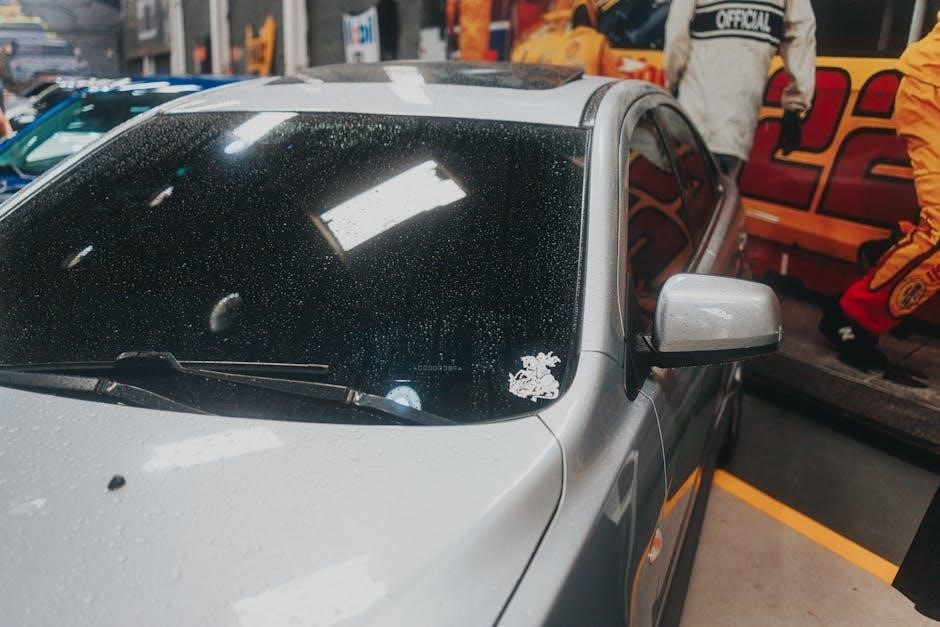
how to close sunroof manually
Manually closing a sunroof is essential when the motor fails or the switch malfunctions. It ensures safety during emergencies and prevents weather-related damage. Using tools like a hex wrench or crank, you can operate the sunroof mechanically, avoiding costly repairs. Always prioritize caution to prevent further damage and ensure proper sealing.
Why Manual Closing Might Be Necessary
Manual closing of a sunroof may be required due to motor failure, a malfunctioning switch, or a broken wire. In such cases, the sunroof may remain open, exposing the interior to weather damage. Additionally, during emergencies like heavy rain or direct sunlight, immediate closure is crucial. If the motor is dead or the system needs resetting, manual intervention ensures safety and prevents further issues. It’s also necessary when the sunroof is stuck open due to damaged gears or tracks, avoiding water ingress or security risks. Knowing how to close it manually provides peace of mind and protects your vehicle from potential harm.
Common Issues with Sunroof Motors
Sunroof motors often encounter problems like worn-out gears, damaged tracks, or electrical connectivity issues. These can cause the motor to fail, leaving the sunroof stuck open or closed. Over time, lack of maintenance such as lubrication can lead to mechanical failure. Additionally, exposure to harsh weather conditions may corrode internal components; Faulty limit switches or control modules can disrupt operation, preventing smooth movement; If not addressed promptly, these issues may escalate, requiring costly repairs. Regular inspection and maintenance are crucial to extend the motor’s lifespan and ensure reliable functionality. Identifying these common problems early can help in taking corrective action before they become major headaches.

Specific Methods for Different Car Models
For Ford Escape, use the manual crank from the glove box. Toyota Corolla requires a hex wrench to turn the motor manually. Acura models may need a reset or direct motor manipulation, while Saturn sunroofs often involve emergency latches. Dodge Hornet owners should refer to specialized tools provided with the vehicle. Each model has unique steps, ensuring safe and effective manual closure without causing further damage.
Ford Escape Manual Closing Procedure
To manually close the sunroof in a Ford Escape, locate the manual crank, typically found in the glove box or with the vehicle’s tool kit. Insert the crank into the designated socket, usually near the rearview mirror. Turn the crank clockwise until the sunroof is fully closed. Ensure the mechanism clicks into place for a secure seal. Avoid using excessive force to prevent damage. If the sunroof is stuck, check for obstructions before proceeding. Once closed, remove the crank and store it safely. This method ensures the sunroof closes properly when the motor fails, keeping your vehicle weatherproof and secure;
Toyota Corolla Sunroof Manual Closure
For a Toyota Corolla, manual sunroof closure involves locating the manual override switch near the ceiling. Press and hold the switch to disengage the motor. Use a hex wrench to turn the motor clockwise, closing the sunroof. Ensure smooth operation by lubricating the tracks. If stuck, gently free the mechanism before proceeding. Regular maintenance, like cleaning drain tubes, prevents future issues. Always handle with care to avoid damage. This method ensures the sunroof closes securely when the motor fails, protecting your vehicle from weather damage. Proper technique and tools are essential for a successful manual closure.
Acura Sunroof Manual Closing Steps
To manually close an Acura sunroof, start by locating the motor, typically found above the rearview mirror. Remove the cover and use a Torx wrench to access the mechanism. Gently pry the lights and cover loose for better access. Insert the wrench into the center socket and turn it clockwise to engage the closing process. Be cautious not to force the movement, as this could damage the tracks. If the shade binds, fully open the roof and free it before attempting to close. Once closed, ensure the sunroof is flush with the roofline for a proper seal. Regular lubrication of tracks and cleaning drain tubes can prevent future issues. Always handle with care to avoid further damage.
Saturn Sunroof Emergency Closing
In emergencies, manually closing a Saturn sunroof involves using the provided FIAT tool. Start by removing the plastic cap located near the sunroof mechanism. Insert the tool into the designated slot and gently turn it to engage the closing process. Ensure the sunroof moves smoothly without forcing it, as this can cause damage. If the shade is stuck, fully open the roof to free it before closing. Once closed, verify the sunroof is secure and level with the roofline. Regular maintenance, such as lubricating tracks and cleaning drain tubes, helps prevent future malfunctions. Always handle the mechanism with care to avoid additional damage and ensure proper sealing.
Dodge Hornet Manual Sunroof Closure
To manually close the sunroof on a Dodge Hornet, locate the motor assembly near the rearview mirror. Remove the cover by prying out the lights and gently taking off the trim. Use a Torx wrench to turn the socket clockwise, which will manually engage the closing mechanism. If the sunroof binds, ensure the movable header or shade is not obstructed. Fully opening the roof may help free the shade before attempting to close it again. Avoid forcing the sunroof, as this could cause further damage. If the issue persists, consider consulting a repair manual or seeking professional assistance to diagnose and fix the problem effectively.
General Methods for Manual Sunroof Closure
Manually closing a sunroof involves using a crank, disconnecting the motor, or employing a hex wrench. Start by locating the manual override, often found near the sunroof or in the glove box. Insert the crank into the designated slot and turn it clockwise to close the sunroof. If the motor is disconnected, use a wrench or hex key to manually operate it. Ensure the sunroof is fully closed and secure to prevent leaks or damage. Always operate carefully to avoid further issues and consider lubricating the tracks for smoother movement. Regular maintenance can help prevent future malfunctions and ensure smooth operation.
Using a Manual Crank
Locate the manual crank, often found in the glove box or with the car’s tool kit. Insert the crank into the designated slot near the sunroof opening. Turn the crank clockwise to close the sunroof panel. Continue until it is fully sealed. For tilt-and-slide models, ensure the panel is aligned properly. If resistance is felt, stop and check for obstructions. This method is effective when the motor fails but requires patience and gentle handling to avoid damage. Proper use of the crank ensures the sunroof closes securely, preventing leaks and maintaining vehicle integrity. Always test the seal by gently tugging the panel after closing.
Disconnecting the Sunroof Motor
To manually close the sunroof by disconnecting the motor, locate the motor assembly, typically near the rearview mirror. Remove the cover, which may involve prying or unscrewing, to access the motor. Using a Torx wrench or similar tool, turn the motor shaft to manually position the sunroof. If the motor is seized, gently apply force but avoid excessive pressure to prevent damage. Once the sunroof is closed, ensure it is fully sealed to prevent leaks. This method is effective when the motor fails but requires caution to avoid further mechanical issues. Always work in a stable environment and test the seal afterward for proper closure.
Hex Wrench Method for Closure
The hex wrench method is a reliable way to manually close a sunroof when the motor fails. Locate the sunroof motor assembly, often behind a removable panel near the rearview mirror. Insert the hex wrench into the designated slot on the motor shaft and turn it clockwise to close the sunroof. Apply steady, gentle pressure to avoid stripping the gears. Continue turning until the sunroof is fully closed and flush with the roof. This method is effective for emergencies and requires minimal tools, making it a practical solution. Ensure the wrench fits securely to maintain control during the process and avoid sudden movements that could damage the mechanism.
Resetting the Sunroof Switch
To reset the sunroof switch, press and hold the close button for 10-30 seconds until you hear a click or see movement. If unsuccessful, repeat the process a few times. This recalibrates the switch, ensuring proper alignment with the motor. If the issue persists, disconnect the car battery for 10 minutes to reset the system. Reconnect and test the switch again. Resetting helps resolve electronic glitches and reestablishes communication between the switch and motor. Regular resets can prevent future malfunctions and ensure smooth operation, especially after manual closures or repairs.

Tools and Equipment Required
Essential tools include a manual crank, screwdrivers, hex keys, wrenches, and pliers. A torque wrench and trim removal tools may also be needed for accessing the motor.
Screwdrivers and Wrenches
Screwdrivers and wrenches are crucial for manually closing a sunroof. Use a flathead screwdriver to remove trim panels, ensuring access to internal mechanisms. A wrench, often a hex or Allen wrench, is necessary for turning the motor’s drive shaft. These tools allow you to bypass the faulty motor, enabling manual closure. Always use the correct size and type of screwdriver or wrench to avoid damaging components. Proper leverage is key to smoothly closing the sunroof without causing further issues. Keep these tools handy to address emergencies effectively and ensure your sunroof operates securely. Regular maintenance can prevent such situations, but when needed, these tools are invaluable.
Hex Keys and Allen Wrenches
Hex keys and Allen wrenches are essential for manually closing a sunroof when the motor fails. These tools allow direct access to the sunroof’s drive mechanism, enabling manual operation. Insert the hex key or wrench into the designated slot on the motor shaft and turn it clockwise to close the sunroof. Be cautious to apply gentle but firm pressure to avoid stripping the mechanism. Regular lubrication of the gears ensures smoother operation. Always keep these tools in your car for emergencies, as they provide a reliable backup solution. Proper use of hex keys and Allen wrenches can prevent weather damage and maintain your sunroof’s functionality until professional repairs are made.
Other Specialized Tools
Beyond hex keys and wrenches, other specialized tools like torque wrenches and manual cranks can be used to close a sunroof manually. These tools are often tailored to specific car models and provide precise control over the sunroof’s movement. A torque wrench ensures even pressure, preventing damage to the mechanism, while a manual crank offers a straightforward way to operate the sunroof when the motor fails. Additionally, some vehicles may require removal of interior panels to access the motor, necessitating tools like screwdrivers and panel removal kits. These tools help ensure safe and effective manual closure, protecting your vehicle from environmental damage until repairs are made.

Safety Considerations
When manually closing a sunroof, avoid using force to prevent damage or injury. Always use proper tools and ensure the vehicle is secure. Be cautious of electrical components and ensure the sunroof is fully closed to avoid weather-related risks.
Precautions to Avoid Injury
Always operate with care to prevent accidents. Ensure the vehicle is stationary and on level ground. Avoid using force, which may cause structural damage or personal harm. Keep loose clothing and jewelry away from moving parts. Never allow children to handle tools or mechanisms unsupervised. Wear protective gloves and eyewear when working with manual tools or electrical components. If unsure, consult a professional to avoid risks. Proper preparation and caution are key to safely closing a sunroof manually.
Preventing Further Damage
Avoid forcing the sunroof, as it can damage tracks or gears. Use appropriate tools like hex wrenches or cranks to guide the mechanism smoothly. Lubricate moving parts regularly to ensure smooth operation. Clean drain tubes to prevent water buildup, which can lead to corrosion. Inspect the motor and switches for wear or loose connections. If the sunroof is stuck, gently manipulate it rather than applying excessive force. Regular maintenance, such as cleaning and lubricating, helps prevent mechanical failures. Addressing issues promptly preserves the sunroof’s functionality and extends its lifespan, avoiding costly repairs.
Emergency Weather Situations
In case of sudden rain or hail, manually closing the sunroof is crucial to protect your car’s interior. Locate the manual crank or hex wrench to operate the mechanism. Avoid forcing the sunroof, as it may damage the tracks or motor. If the sunroof is stuck, gently manipulate it to prevent further issues. During emergencies, prioritize sealing the sunroof to prevent water ingress. If the motor fails, use the override method to ensure closure. Always keep the necessary tools accessible to act quickly in adverse weather conditions. Timely action can prevent damage and ensure your car remains dry and secure during unexpected weather events.

Maintenance Tips
Regular maintenance ensures smooth sunroof operation. Lubricate tracks, clean drain tubes, and inspect mechanisms to prevent issues. Address wear early to avoid costly repairs later.
Lubricating Sunroof Tracks
Lubricating sunroof tracks is crucial for smooth operation. Use a silicone-based spray to reduce friction and prevent rust. Clean tracks first to remove dirt and debris. Apply lubricant evenly, ensuring coverage of all moving parts. Avoid over-lubrication, as it can attract dust. Regular lubrication prevents sticking and ensures the sunroof opens and closes effortlessly. This maintenance step is especially important after cleaning or if the sunroof has been stationary for a long time. Lubricating tracks also helps extend the lifespan of the sunroof mechanism. Always follow the manufacturer’s recommendations for the best results and to avoid damaging the system.
Cleaning Drain Tubes
Cleaning sunroof drain tubes is vital to prevent water accumulation and potential leaks. Locate the tubes at the sunroof’s corners and remove any debris or blockages. Use a soft brush or compressed air to clear the passages. Ensure the tubes are free-flowing to direct water away from the vehicle’s interior. Regular cleaning prevents mold growth and unpleasant odors. If the tubes are clogged, water may seep into the car, causing damage. Always inspect and clean the drain tubes during routine maintenance to maintain proper sunroof function and protect your vehicle’s interior. This simple step can prevent costly repairs and ensure your sunroof operates efficiently.
Regular Inspection of Mechanisms
Regular inspection of sunroof mechanisms is crucial for maintaining smooth operation; Check the gears, cables, and tracks for wear or damage. Use a flashlight to examine hidden areas and ensure all components are securely fastened. Clean debris from tracks to prevent obstruction. Lubricate moving parts periodically to reduce friction. Inspect the motor and switches for signs of wear or corrosion. Addressing issues early prevents sudden malfunctions. Schedule professional inspections if unsure about any component. Regular checks help avoid unexpected breakdowns and ensure your sunroof functions reliably. A well-maintained mechanism reduces the risk of manual closure becoming necessary. Stay proactive to enjoy hassle-free sunroof use.

Troubleshooting Common Issues
Identify broken gears, stuck motors, or damaged tracks early to prevent further damage. Use tools like hex wrenches or screwdrivers for repairs, ensuring smooth sunroof operation.
Identifying Broken Gears
Broken gears are a common issue causing sunroof malfunction. Look for unusual noises, such as grinding or clicking sounds, when attempting to operate the sunroof. If the sunroof jerks or stops mid-motion, gears may be damaged; Inspect the gear mechanism by removing the motor cover. Visually examine for worn or broken teeth. Use a flashlight for better visibility. If gears are damaged, lubricate lightly or replace them if necessary. Addressing this early prevents further damage to the sunroof system. Always handle gears gently to avoid causing additional breaks. Regular maintenance, like cleaning and lubricating tracks, can reduce the risk of gear failure.
Fixing Damaged Tracks
Damaged tracks can prevent a sunroof from closing properly. Inspect the tracks for dents, rust, or debris. Clean any obstructions with a soft brush or cloth. Lubricate the tracks with silicone spray to ensure smooth movement. If tracks are dented, gently hammer them back into shape. For rusted parts, apply a rust remover and repaint. In severe cases, replace damaged sections. Avoid forcing the sunroof, as it can worsen the issue. Regular maintenance, including cleaning and lubrication, helps prevent track damage. Addressing track problems promptly ensures the sunroof operates smoothly and avoids costly repairs. Always use appropriate tools to prevent further damage during the repair process.
Dealing with Stuck Motors
A stuck sunroof motor can leave the roof open or closed, causing inconvenience. First, disconnect the motor to prevent further damage. Use a hex wrench or manual crank to override the motor and close the sunroof. Apply gentle, consistent pressure to avoid breaking gears or tracks. If the motor is seized, inspect for debris or rust and clean as needed. Lubricate moving parts with silicone spray to restore functionality. Avoid forcing the motor, as this can lead to permanent damage. If manual methods fail, consider replacing the motor or seeking professional help. Regular maintenance, such as cleaning and lubricating, can prevent motors from sticking and ensure smooth operation. Addressing the issue promptly prevents weather-related damage and maintains your car’s integrity.

Alternative Methods
Alternative methods include using makeshift tools or vacuum pressure to close a stuck sunroof. These techniques provide temporary solutions until professional repairs can be made, ensuring safety and functionality.
Using a Makeshift Tool
Using a makeshift tool can be an effective way to manually close a sunroof when standard tools are unavailable. A sturdy metal rod, screwdriver, or even a wrench can serve as a temporary solution. Insert the tool into the sunroof’s manual override slot, typically located near the motor, and gently pry or turn it to guide the panel closed. Ensure the tool is sturdy enough to avoid bending or breaking. Apply steady, controlled force to prevent further damage to the tracks or motor. This method is ideal for emergencies but should be followed by proper repairs to restore electronic functionality and ensure long-term reliability.
Applying Vacuum Pressure
Applying vacuum pressure is an innovative method to manually close a stuck sunroof. Attach a plastic cup or a specialized vacuum tool to the sunroof panel, creating a secure seal. Gently press down to form suction, then pull upward to guide the panel shut. This method relies on the material of the sunroof and the strength of the vacuum seal. Be cautious not to apply excessive force, which could damage the panel or surrounding trim. While effective in emergencies, it’s important to address the underlying issue promptly to ensure proper functionality. This technique provides a temporary solution, allowing you to close the sunroof until professional repairs can be made.
Forcing Closure as a Last Resort
Forcing the sunroof to close should only be considered when all other methods fail. This approach carries a risk of damaging the mechanism or the roof. If the sunroof is stuck open, use a sturdy tool like a wrench or screwdriver to gently pry it shut. Apply even pressure on both sides to avoid warping the panel. Once closed, ensure it is securely latched to prevent further issues. However, this method is not recommended as it can cause permanent damage to the tracks or motor. Always prioritize safer alternatives, such as using a hex wrench or manual crank, before resorting to force. If damage occurs, seek professional assistance to repair or replace the affected components.
Manually closing a sunroof is a valuable skill for emergencies. Always prioritize safety, use proper tools, and avoid forcing closure to prevent damage. Stay prepared and proactive.
Importance of Knowing Manual Closure
Knowing how to manually close a sunroof is crucial for preventing water damage during unexpected malfunctions. It ensures safety during emergencies, such as bad weather, by allowing quick closure; Understanding the process saves time and money by avoiding costly repairs. Regular maintenance, like lubricating tracks and cleaning drains, can prevent issues, but manual skills remain essential. Familiarity with tools like hex wrenches and cranks empowers drivers to handle situations confidently. This knowledge not only enhances preparedness but also extends the lifespan of the sunroof mechanism, ensuring smooth operation for years to come. Stay proactive to avoid minor issues becoming major problems.
Preparedness for Emergencies
Preparedness for emergencies involving a sunroof is vital to ensure safety and prevent damage. Knowing how to manually close a sunroof can save you from unexpected situations like heavy rain or extreme weather. A stuck or broken sunroof can lead to water ingress, damaging interiors and electrical systems. Familiarizing yourself with manual closure methods ensures quick action during emergencies. Tools like hex wrenches or cranks should be readily available to avoid delays. Being proactive also helps prevent further mechanical issues, saving time and money. Always prioritize learning manual closure techniques to stay prepared for any unforeseen circumstances, ensuring your vehicle remains secure and functional in critical moments.

Additional Resources
Explore recommended repair manuals, join online forums, and consult professional mechanics for comprehensive guidance on manually closing your sunroof. These resources offer detailed instructions, troubleshooting tips, and expert advice for a successful repair.
Recommended Repair Manuals
Consulting a recommended repair manual provides detailed, model-specific instructions for manually closing your sunroof. These manuals often include diagrams and step-by-step guides, ensuring you understand the process thoroughly. They cover various car models, such as Ford Escape, Toyota Corolla, and Acura, offering tailored advice. Additionally, repair manuals highlight essential tools like hex wrenches and screwdrivers, helping you prepare. By following these manuals, you can address issues confidently, whether it’s disconnecting the motor or using a crank. They also emphasize safety and proper techniques to prevent damage. Using a repair manual is a reliable way to resolve sunroof issues effectively and efficiently.
Online Forums and Communities
Online forums and communities are invaluable resources for learning how to close a sunroof manually. Websites like Reddit, car enthusiast forums, and specialized repair communities often feature detailed discussions and DIY solutions. Users share personal experiences, troubleshooting tips, and step-by-step guides for various car models. These forums can help you identify common issues, such as broken gears or faulty motors, and provide creative solutions like using makeshift tools or applying vacuum pressure. Many contributors also recommend specific tools, such as hex wrenches or screwdrivers, and offer advice on lubricating tracks or resetting switches. Engaging with these communities can provide real-world insights and practical advice to address your sunroof concerns effectively.
Professional Assistance Options
When manual closing methods fail, seeking professional assistance is the best course of action. Certified mechanics or auto electricians specialize in diagnosing and repairing sunroof systems. Dealerships often provide genuine parts and warranty-backed services, ensuring reliable fixes. Additionally, specialized auto shops may offer cost-effective solutions tailored to your vehicle. Professional assistance not only resolves the immediate issue but also prevents further damage. They can address complex problems like motor replacements or track realignments, ensuring your sunroof operates smoothly. Consulting a professional guarantees safety and efficiency, especially for those unfamiliar with manual procedures or advanced repairs. This option is ideal for long-term solutions and peace of mind. Prioritize professional help for intricate or persistent sunroof issues.